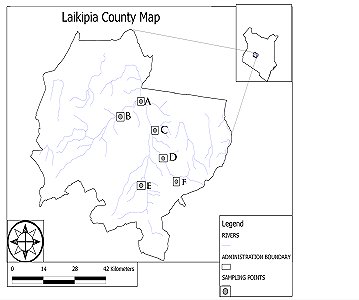IUCN/SSC Otter Specialist Group Bulletin

|
©IUCN/SCC Otter Specialist Group Volume 31 Issue 1 (January 2014) Citation: Njoroge, C.H., Ogada, M. O. and Gichuki, N. N. (2014).Temporal Detection Patterns of the African Clawless Otter Aonyx capensis (Schinz, 1821) in the Laikipia Plateau of Central Kenya. IUCN Otter Spec. Group Bull. 31 (1): 44 - 48 Temporal Detection Patterns of the African Clawless Otter Aonyx capensis (Schinz, 1821) in the Laikipia Plateau of Central Kenya Chege H. Njoroge1, Mordecai O. Ogada2 and Nathan N. Gichuki3
1Kenya Wetland Biodiversity Research Team, National Museums of Kenya, P.O BOX 40658-00100Nairobi, Kenya. Email:
chegeherman@gmail.com> |


 |
| Received 23rd January 2014, accepted 11th May 2014 |
| Abstract: The detection time of the African clawless Otter along its habitat was studied from January 2013- April 2013 over 720 trap nights. Camera traps were set up in six sites of different altitudes along the riparian area of the Ewaso Nyiro River in Central Kenya. Based on the still pictures and the time recorded in the snapshot: 50.68% of their occurrence was found to be between 18h00 and 00h00 in the evening, 41.78% between 00h00 and 06h00 in the morning and an insignificant 7.53% between 06h00 and 18h00 during the day. This evidence suggests a temporal detection niche for the African clawless Otter in this ecosystem, which is empirical verification in line with its known cryptic and nocturnal behavior. |
| Keywords: Laikipia, Aonyx capensis, detection, temporal, niche, and camera traps |
| Française | Español |
INTRODUCTION
The African clawless otter is listed as a species of least concern by the International Union for the Conservation of Nature (Hoffmann, 2008). However, relatively few ecological studies have been conducted on the species outside of southern Africa. Comprehensive assessments of the feeding habitats and distribution of the African clawless otter have been conducted in southern Africa environments (Nel and Somers, 2007; Parker et al., 2007; Somers and Nel, 2005; Watson and Lang, 2003). The ecology of the African clawless otter is for the most part not well studied in East Africa. In fact, only two studies for the species have been conducted in the region, both focusing on feeding habits in freshwater habitats (Kruuk and Goudswaard, 1990; Ogada, 2007).
Studies of the activity patterns of African clawless otter have been conducted through radio-telemetry (Somers and Nel, 2005). However, activity pattern of the species has not been widely monitored in Africa through the use of remote-sensing cameras. Use of remote-cameras has provided useful information of riparian visitation patterns for other otter species at latrines e.g. the Eurasian Otter (Lutra lutra) (MacDonald and Harrington, 2012). Our study therefore, is designed to provide insight into the detection patterns of the African clawless in riparian areas along riverine habitats in north central Kenya through the use of similar remote-sensing cameras.
STUDY AREA
Our study was conducted in the Laikipia county of North-central Kenya in over 100Km of the Ewaso Nyiro River. The Laikipia plateau is located east of the Great Rift Valley between latitudes 0°17′S–0°45′N and longitudes 36°10′E–37°3′E hemmed in the west by the Aberdares range, to the south and south-east by Mt. Kenya, and to the east by the Mukogodo hills. It averages 2000 m in altitude and rises to over 2500 m on the Aberdares slopes and 2250 m on the slopes of Mt. Kenya. With an area of about 9723 km2, most of Laikipia is low country with numerous broad and generally grassy volcanic ridges cut into by two major rivers, the Ewaso Narok and Ewaso Nyiro, with various tributaries flowing down from the Aberdares and Mt. Kenya. (Wambuguh, 2007). The specific study sites were along the Ewaso Nyiro River at the Timau-Nanyuki rivers junction at Jua kali (D), Nanyuki-Ewaso nyiro junction to the north of Mpala (C), Ewaso Nyiro-Ewaso-Narok junction at Lamarti camp (A), Sosian bridge on the Ewaso Narok river (B), William Holden Bridge on the Northern Ondare river (F) and Kibubungi on the Upper Ewaso Nyiro on the South West corner of Ol pejeta (E) (Fig 1)
 |
| Figure 1. Study area. (click for larger version) |
METHODS
Twenty one potential sampling points at the Ewaso Nyiro river system were identified from previous preliminary otter latrine surveys. Six sites were randomly selected from the 21 latrine sites and monitored for 720 camera trap nights between January and April 2013. Camera traps (Moultrie Game Spy M-80 series ®) were placed in the selected otter latrines at 0.5-metres above the ground and fastened onto firm structures such as tree stems and stumps around the otter latrine area. They were concealed as much as possible to avoid theft whilst leaving enough room for the lens to clearly capture the animals clearly. Scent lures were also applied on twigs around the camera and placed within the camera range i.e. < 5 meters on the trail. The data from the cameras were downloaded from their respective memory cards fortnightly, as well as re-baited with new scent lures and checked if the memory stick and batteries were still functional. The settings used were such that there was a delay of 5 minutes between each exposure to increase chances of unique detections as opposed to the same individual. The trap was also set in such a way that the date and time of each shot was recorded at the base of each picture. The cameras were left to survey day and night over the study period. Information from each camera was then analyzed to look for temporal detection patterns. The interest of the study was not identification of unique animals but temporal detection patterns and hence detection from the same individual was considered unique as long as it was in different time quarters i.e. 00h00 – 06h00,06h00-1200h,1200 - 18h00,18h00 – 00h00.
RESULTS AND DISCUSSION
Cameras were functional for 87.8% of the time due to technical (Memory card and battery) issues and hence there was a a net camera Trap Night (TN) of 632 TN out of the initially envisioned 720 TN. Overall trap success for all cameras combined was therefore 23.1 captures per 100 (TN). Camera location E had the highest trap success at (10.3/100 TN), followed by: A (9.01/100 TN); C (3.48/100 TN) and F (0.32/100 TN). Camera locations B & D did not have any detections.
In total one hundred and forty-six detections were recorded (Table 1), 65 in camera location E, 57 in camera location A, 22 in camera location C and 2 in camera location F. Two camera locations B & D did not have any detections. Detections were recorded for 23 days at camera E, 18 days at camera A, 7 days at camera C and 1 Day at camera F; overall detections recorded was 49 days at all the cameras, with no detections in B & D.
Most detections occurred during the night in the study period, with 92.46% i.e. 41.78% between 00h00 – 06h00 and 51.68% between 18h00 – 00h00 representing occurrences at night. Only 7.53% occurred between 06h00 –18h00 i.e. during the day, and when they did occur, they did so either very early in the morning at dusk or very late in the evening at dawn.
Laikipia virtually being on the equator at a latitude of 0°17′S–0°45′N and an average Sunrise of 06h35 and Sunset at 18h43 , provides an almost ideal 12–hour day and night experimental window for a temporal study.
It was interestingly observed that the African clawless Otter intentionally avoided expressly using its territory during the day. A further insightful look into the study sites reveals that sites near small agricultural farms growing subsistence maize and potatoes produced more occurrences on the trail. This coupled with complaints by the farmers on destruction of their young plant shoots; might suggest that the African clawless Otter is a probable vermin for these small scale farmers.
In principle, as humans continue to expand their distribution into habitats that have historically contained carnivores, there will be a more pressing need for temporal datasets examining both behavioral and ecological parameters of carnivores for sustained co-existence. (Beckmann & Berger, 2003).The relatively new remote camera traps methods provides such an opportunity for studying of these temporal niches for such cryptic species as the African clawless Otter.
CONCLUSION
Our data offer an empirical evidence of the nocturnal detection pattern of the African clawless Otter by showing how it has managed to carve out its own crepuscular foraging niche in the Laikipia ecosystem. This conclusions would however be complemented if observation of these nocturnal detection pattern can be carried out in different geographical areas to determine if this behavior is universal for this species.
Acknowledgements - This research would not have been possible were it not for the moral, material and mentorship of the Laikipia Wildlife Forum Secretariat and institutional assistance offered by the Kenya Wetland Biodiversity Research Team (KENWEB) based at the National Museums of Kenya.
REFERENCES
Arden-Clarke, C. H. G. (1986). Population density, home range size and spatial organization of the Cape clawless otter Aonyx capensis in a marine habitat. Journal of Zoology, London. 209: 201-211.
Beckmann, J.P., Berger, J. (2003). Rapid ecological and behavioral changes in carnivores: the responses of black bears (Ursus americanus) to altered food. Journal of Zoology, London. 261: 207–212.
Gese, E.M. (2001). Monitoring of terrestrial carnivore populations. USDA National Wildlife Research Center. (Staff Publications paper 576.)
Hoffmann, M. (2008). Aonyx capensis. In: IUCN 2013. IUCN Red List of Threatened Species. <www.iucnredlist.org>. Downloaded on 22 July 2013.
Kruuk, H., Goudswaard, P.C. (1990). Effects of changes in fish populations in Lake Victoria on the food of otters (Lutra maculicollis Schinz & Aonyx capensis Lichtenstein). African Journal of Ecology, 28: 322–329.
MacDonald, D., Harrington, L. (2012). A pilot study to assess the feasibility of using camera trap surveys to estimate otter numbers. Wildlife Conservation Research Unit, Department of Zoology, University of Oxford.
Nel, J.A.J., Somers, M.J. (2007). Distribution and habitat choice of Cape clawless otters, in South Africa. South African Journal of Wildlife Research, 37(1): 67–70.
Ogada, M.O. (2007). Effects of the Louisiana crayfish invasion on the food and territorial ecology of the African clawless Otter in the Ewaso Ng’iro ecosystem, Kenyatta University (Ph.D. thesis), Kenya.
Parker, D.M., Burchell, R. K., Bernard, R.T.F. (2007). The diet of Cape clawless otters at two sites along the Bloukrans River, Eastern Cape Province, South Africa. Wildlife and Reserve Management Research Group, Department of Zoology and Entomology, Rhodes University, Grahamstown.
Rowe-Rowe, D.T. (1977a). Food ecology of the African clawless Otter in Natal, South Africa. Oikos. 28: 210-219.
Rowe-Rowe, D. T. (1977b). Prey capture and feeding behavior of South African otters. Lammergeyer. 23:13-21.
Somers, M.J. (2000). Foraging behavior of Cape clawless otters Aonyx capensis in a marine habitat. Journal of Zoology, London. 252: 473-480.
Somers, M.J., Nel, J.A.J. (2005). Habitat selection by the Cape clawless otter (Aonyx capensis) in rivers in the Western Cape Province, South Africa. African Journal of ecology. 42(4): 298-305.
Van der Zee, D. (1982). Density of Cape clawless otters Aonyx capensis in the Tsitsikama Coastal National Park. South African Journal of Wildlife Research, 12: 5 -13.
Wambuguh, O. (2007). Interactions between Humans and Wildlife: Landowner Experiences Regarding Wildlife Damage, Ownership and Benefits in Laikipia District, Kenya. Conservation and Society, 5 (3): 408–428.
Watson, L.H., Lang, A.J. (2003). Diet of Cape clawless otters in Groenvlei Lake, South Africa. South African Journal of Wildlife Research 33(2): 135–137
Résumé : Profil Temporel de Détection de la Loutre Africaine à Joues Blanches, Aonyx capensis (Schinz, 1821), sur le Plateau Laikipia du Kenya Central
La période de détection de la Loutre Africaine à joues blanches le long de son habitat a été menée de Janvier 2013 à Avril 2013 avec l’utilisation de 720 cameras nocturnes. Ces caméras ont été placées sur 6 sites à différentes altitudes le long de la zone riparienne de la rivière Ewaso Nyiro au Kenya central. Basé sur les photos obtenues et l’heure indiquée sur le cliché, 50,68% de leurs apparitions se situent le soir entre 18h00 et minuit, 40,78% le matin entre minuit et 06h00 et de façon non significative 7,53% entre 6H00 et 18H00 la journée. Cette preuve suggère un créneau temporel de détection de cette Loutre Africaine à joues blanches dans son écosystème, qui constitue une vérification empirique en accord avec son comportement cryptique et nocturne connu.
Revenez au dessus
Resumen: Patrones Temporales de Detección de la Nutria de Mejillas Blancas Aonyx capensis (Schinz, 1821) en la Meseta de Laikipia, Kenia Central
Estudiamos los períodos de detección de la nutria de mejillas blancas africana, a lo largo de su hábitat, desde Enero de 2013 a Abril de 2013, en base a 720 noches-cámara. Dispusimos cámaras-trampa en seis sitios a diferentes altitudes a lo largo del área ribereña del Río Ewaso Nyiro en Kenia Central. Basados en las fotos obtenidas y la hora registrada en la misma: 50.68% de las ocurrencias fueron entre 18h00 y 00h00 por las tardes-noches, 41.78% entre 00h00 y 06h00 -mañanas- y un insignificante 7.53% entre 06h00 y 18h00 durante el día. Esta evidencia sugiere un nicho de detección temporal para la nutria de mejillas blancas Africana en este ecosistema, lo cual constituye una verificación empírica en línea con su comportamiento conocido, críptico y nocturno.
Vuelva a la tapa